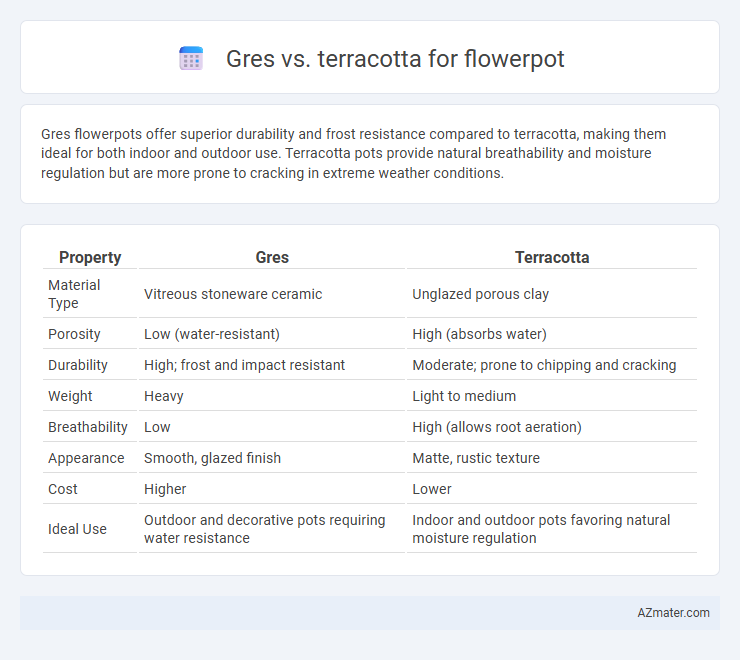Gres flowerpots offer superior durability and frost resistance compared to terracotta, making them ideal for both indoor and outdoor use. Terracotta pots provide natural breathability and moisture regulation but are more prone to cracking in extreme weather conditions.
Table of Comparison
| Property | Gres | Terracotta |
|---|---|---|
| Material Type | Vitreous stoneware ceramic | Unglazed porous clay |
| Porosity | Low (water-resistant) | High (absorbs water) |
| Durability | High; frost and impact resistant | Moderate; prone to chipping and cracking |
| Weight | Heavy | Light to medium |
| Breathability | Low | High (allows root aeration) |
| Appearance | Smooth, glazed finish | Matte, rustic texture |
| Cost | Higher | Lower |
| Ideal Use | Outdoor and decorative pots requiring water resistance | Indoor and outdoor pots favoring natural moisture regulation |
Introduction: Gres vs Terracotta Flowerpots
Gres flowerpots, crafted from dense stoneware clay, offer exceptional durability and resistance to frost, making them ideal for outdoor use across diverse climates. Terracotta flowerpots, made from porous, fired clay, provide excellent breathability for plant roots but require careful handling to prevent cracking in cold conditions. Choosing between gres and terracotta depends on factors like environmental exposure, plant type, and aesthetic preferences.
Material Composition: Gres and Terracotta Explained
Gres flowerpots are made from high-fired, dense stoneware clay, resulting in a durable, non-porous material resistant to frost and water absorption. Terracotta pots consist of low-fired, porous clay that allows better airflow and moisture evaporation, promoting healthy root growth but requiring more frequent watering. The difference in firing temperature and clay composition fundamentally impacts the pot's weight, breathability, and durability for plant cultivation.
Durability and Longevity Comparison
Gres flowerpots, made from vitrified porcelain, offer superior durability and resistance to chipping, cracking, and weathering compared to terracotta, which is more porous and prone to deterioration over time. Terracotta pots, while breathable and beneficial for plant root health, tend to absorb moisture, leading to potential cracking in freezing conditions and a shorter lifespan. Gres pots maintain structural integrity and aesthetics longer, making them a more durable choice for outdoor and long-term use.
Water Absorption and Breathability
Gres flowerpots exhibit low water absorption rates, typically below 0.5%, making them highly resistant to moisture and ideal for outdoor use in wet climates. Terracotta pots have higher porosity, absorbing up to 20% of water, which enhances breathability and allows better air circulation to plant roots. This natural evaporation process in terracotta helps prevent overwatering, while gres pots retain moisture longer, benefiting drought-tolerant plants.
Weight and Handling Differences
Gres flowerpots are denser and heavier due to their high-fired stoneware composition, offering increased durability but requiring more effort to move and handle. Terracotta pots are lighter and more porous, making them easier to lift and reposition but more fragile and prone to chipping or cracking. The weight differences significantly impact portability and suitability for larger planters and outdoor settings where frequent handling is necessary.
Aesthetic Appeal and Design Options
Gres flowerpots offer a sleek, modern aesthetic with smooth finishes and subtle color variations, making them ideal for contemporary design schemes. Terracotta pots provide a warm, rustic charm with their natural reddish-brown hues and porous texture, enhancing traditional and Mediterranean-style gardens. The design options for gres include minimalist shapes and muted tones, while terracotta allows for handcrafted patterns and a more organic, earthy appearance.
Cost Analysis: Gres vs Terracotta
Gres flowerpots typically have a higher upfront cost compared to terracotta due to their dense, vitrified material and manufacturing process, which increases durability and longevity. Terracotta pots are generally more affordable, making them a popular choice for budget-conscious gardeners, but they may require more frequent replacement due to fragility and porosity. When considering long-term expenses, gres pots offer better value as they resist cracks and weathering better than terracotta, reducing replacement and maintenance costs over time.
Best Uses for Each Material
Gres flowerpots excel in durability and frost resistance, making them ideal for outdoor use in harsh climates and heavy plants requiring stable containers. Terracotta pots offer excellent breathability and moisture regulation, perfect for Mediterranean plants and indoor gardening where moderate watering is needed. Choosing gres suits long-term outdoor planting, while terracotta benefits plants that thrive in well-aerated soil environments.
Environmental Impact and Sustainability
Gres flowerpots, made from dense, high-fired stoneware, offer enhanced durability and lower water absorption, significantly reducing waste and extending product lifespan compared to terracotta. Terracotta pots, while biodegradable and porous, require more frequent replacement due to fragility, increasing resource consumption and environmental footprint. Choosing gres contributes to sustainability by minimizing raw material use and energy through long-term usage, aligning with eco-friendly gardening practices.
Choosing the Right Flowerpot for Your Plants
Gres flowerpots offer superior frost resistance and durability, making them ideal for outdoor use and long-term plant health. Terracotta pots provide excellent breathability and moisture regulation, promoting root aeration essential for plants that prefer well-drained soil. Selecting between gres and terracotta depends on your plant's watering needs and the environmental conditions where the pot will be placed.

Infographic: Gres vs Terracotta for Flowerpot
 azmater.com
azmater.com